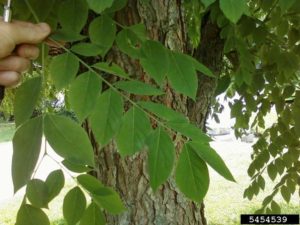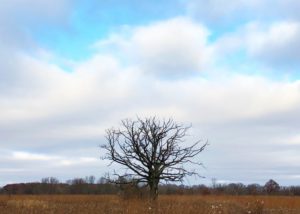By Olivia Witthun, DNR regional urban forestry coordinator, Plymouth, Olivia.Witthun@wisconsin.gov, 414-750-8744
 Are you going stir-crazy stuck inside your house or apartment? Take a visit to the forest outside your door! Step outside to enjoy the sights, sounds and smells of the trees and nature around you. It’s good for your mind, body and soul. Research shows exposure to nature reduces depression, anxiety and stress! Plus, we all know physical activity keeps your body healthy and boosts your mood.
Are you going stir-crazy stuck inside your house or apartment? Take a visit to the forest outside your door! Step outside to enjoy the sights, sounds and smells of the trees and nature around you. It’s good for your mind, body and soul. Research shows exposure to nature reduces depression, anxiety and stress! Plus, we all know physical activity keeps your body healthy and boosts your mood.
Eighty percent of American adults are afflicted by stress. Forty million are affected by anxiety disorders, and nearly sixteen million experience major depression each year. If you live in the city, those numbers are even higher. Urban dwellers have a 20% higher risk for developing anxiety disorders, 40% for mood disorders and double for schizophrenia. Stress has become a constant in people’s everyday lives, and the COVID-19 just adds even more. The cumulative effects of chronic stress can have serious health consequences over time, including: depression, anxiety, heart disease, high blood pressure, chronic pain and type 2 diabetes.
Continue reading “Visit the forest outside your door” →


 Happy Arbor Day! Join us in celebrating from home today. Post a photo of your favorite tree on social media, tag @arborday, and use the hashtag #arbordayathome. The Arbor Day Foundation will plant a tree on your behalf.
Happy Arbor Day! Join us in celebrating from home today. Post a photo of your favorite tree on social media, tag @arborday, and use the hashtag #arbordayathome. The Arbor Day Foundation will plant a tree on your behalf. To keep everyone safe and healthy during this pandemic, the Arbor Day Foundation is suspending the requirement to hold a public Arbor Day celebration in 2020. Communities will be able to maintain their Tree City/Campus/Line designations without meeting this standard.
To keep everyone safe and healthy during this pandemic, the Arbor Day Foundation is suspending the requirement to hold a public Arbor Day celebration in 2020. Communities will be able to maintain their Tree City/Campus/Line designations without meeting this standard. With thousands of trees on their properties, municipalities and other urban ownerships sometimes need to remove a large volume of trees at once, such as after an insect or disease outbreak (i.e., emerald ash borer) or a catastrophic weather event (wind/tornadoes or ice/snow damage). When this need arises, what are the options available to remove these trees efficiently, safely, cost effectively and quickly?
With thousands of trees on their properties, municipalities and other urban ownerships sometimes need to remove a large volume of trees at once, such as after an insect or disease outbreak (i.e., emerald ash borer) or a catastrophic weather event (wind/tornadoes or ice/snow damage). When this need arises, what are the options available to remove these trees efficiently, safely, cost effectively and quickly?  Are you going stir-crazy stuck inside your house or apartment? Take a visit to the forest outside your door! Step outside to enjoy the sights, sounds and smells of the trees and nature around you. It’s good for your mind, body and soul. Research shows exposure to nature reduces depression, anxiety and stress! Plus, we all know physical activity keeps your body healthy and boosts your mood.
Are you going stir-crazy stuck inside your house or apartment? Take a visit to the forest outside your door! Step outside to enjoy the sights, sounds and smells of the trees and nature around you. It’s good for your mind, body and soul. Research shows exposure to nature reduces depression, anxiety and stress! Plus, we all know physical activity keeps your body healthy and boosts your mood.  Wisconsin Urban Wood is conducting a research project with support from the Forest Service to develop and demonstrate best practice standards for urban wood utilization in Wisconsin; including describing the:
Wisconsin Urban Wood is conducting a research project with support from the Forest Service to develop and demonstrate best practice standards for urban wood utilization in Wisconsin; including describing the: